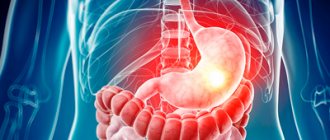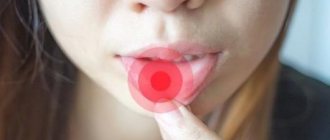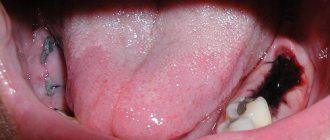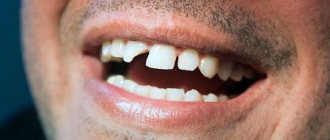Possible reasons for the appearance of a lump on the gum after tooth anesthesia
Since the doctor makes the injection blindly, there is a risk of hitting a blood vessel. This explains why a bruise appears on the cheek or gum. In many cases it is considered the norm. Hematoma may also occur while taking certain medications that affect the blood's ability to clot. This could be, for example, Heparin, Aspirin, and many NSAIDs. A number of factors contribute to the appearance of a lump after the administration of an anesthetic:
- drinking alcoholic beverages before visiting the dental office;
- high blood pressure - hypertension;
- consuming too hot food or drinks shortly after dental treatment.
Swelling near the injection site is not considered a deviation from the norm. Often such manifestations are subjective in nature - a person may feel severe tissue swelling, although in fact the swelling is insignificant. But in some cases, these signs can lead to complications, so it is necessary to understand when the pathological process develops.
Diagnostic and treatment methods
To exclude hidden lesions of the tooth and soft tissues, the doctor refers the patient to an X-ray. Treatment always begins with removal of pus. The specialist carefully opens the gum and cleans it of dead tissue, after which he treats the cavity with antiseptics. To defeat the infection, the patient must take antibiotics and anti-inflammatory drugs prescribed by the doctor. If pathogenic microorganisms have not penetrated into the deep layers of tissue, this is usually enough to stop inflammation.
If the image shows that the main source of inflammation is in the canals of the tooth, then the filling will have to be removed. The doctor will remove it, thoroughly clean the root canals, place a temporary filling and set a date for a follow-up examination. It will be possible to fill the tooth again only after the photo shows that the inflammatory process has stopped.
Sometimes the cause of suppuration is damage to the apex of the tooth root. To save it, the doctor performs an operation - resection. During it, only the affected root tissue is removed.
Treatment of gum suppuration always includes taking antibacterial drugs. They help destroy infectious agents and prevent relapse.
Physiotherapeutic methods are also widely used in dentistry. Electrophoresis, ultrasound and laser help speed up tissue restoration, increase local immunity, and relieve swelling. Physiotherapy is prescribed only after the inflammatory process has stopped. The duration of the course for each patient is determined individually.
Why does pain occur after an injection into the gum?
Since the needle is inserted into soft tissues, it injures them and provokes discomfort. The patient may feel pain at the injection site for 1-2 days, or even more. The duration of the recovery period depends on the characteristics of the body and the perception of stimuli at the neuropsychic level.
Overly sensitive patients should be prepared for aching pain. Most often, no action is required. Usually the pain subsides on its own. In the case when it does not go away and only gets worse over time, we can talk about the development of a complication. At the same time, other signs of disturbances may occur.
Sometimes the patient thinks that the injection site hurts, but the localization is in a different place. So, after caries treatment, you may feel aching pain that radiates to the gums. Removal of a wisdom tooth is accompanied by pain in the socket, while the patient thinks that the problem is localized at the injection site.
Dangerous symptoms
Today, laser caries treatment is often used. Such manipulations do not cause pain if the dentist follows the technology. No painkillers are required. This therapy technique is especially suitable for those who are afraid of injections. The use of this method of treatment eliminates the drill and vibrations from it. This therapy is also comfortable for the patient.
If you experience an unpleasant symptom after the injection and it does not go away within 3-4 days, you should consult a doctor. Serious symptoms that indicate a problem may include gumboil and abscess, ulcers and spots on the gum tissue, or the formation of a large cyst. In such a situation, you should not hesitate to visit the doctor, so as not to worsen the consequences.
Complications after injection of anesthetic into the gums
Depending on the amount of blood released from the vessel and the individual characteristics of the body, it often takes 4 to 10 days for a bruise on the gum to disappear. Otherwise, this is already a complication.
| Type of complication | Features of manifestation | Symptoms |
| Accession of infection | There are always millions of bacteria in your mouth. In a normal state, they are in a certain balance, but under favorable conditions, for example, when immunity decreases, they can be activated. Thus, clotted blood becomes a nutrient medium for them. Pathogens begin to multiply. Pathogenic microorganisms can spread to periodontal tissue, the alveolar process that holds the tooth, periosteum and bone. Much depends on the type of pathogen and the location of the bruise. | Tissue infection is accompanied by the following symptoms: · painful sensations; · temperature increase – up to 39 ˚С; · weakness; · headache; Redness of the gum tissue. |
| Damage to the nerve trunk | If the doctor acts incorrectly, nerve fibers may be damaged as a result of the administration of anesthesia. In this case, it is important to contact a neurologist and maxillofacial surgeon as quickly as possible. | The patient feels a sharp pain immediately when the injection is given. It will subside for the duration of the anesthetic, but then resume again. It cannot be stopped even with the help of painkillers. If a large nerve trunk is affected, pain will be felt throughout the entire mouth, cheek and ear. It is even possible to turn off the chewing function and numbness of the face. Sometimes it is difficult to open your mouth completely; one side may sag. |
| Tissue necrosis | A very dangerous complication. The reason for its development may be the patient’s ailment, which he was silent about, vasospasm, too much anesthetic or its rapid administration. | The patient first feels a sharp, growing pain. It subsides for a short time, but this does not indicate that the danger has passed. The pain disappears due to tissue death. |
Complications after tooth extraction often occur due to the penetration of bacteria through the hole into various tissues of the dentofacial apparatus. Pus accumulates.
Features of anesthesia
Today in dentistry, pain relief is very often used by injecting an anesthetic with a syringe. This is convenient for the dentist and makes it possible to reliably turn off sensitivity during any surgical interventions. You can learn how the most common types of pain relief in dentistry are performed by watching the video in this article.
Infiltration and conduction techniques are mainly used. The big advantage is that this allows you to act locally without having a toxic effect on the entire body.
Infiltration anesthesia is carried out directly in the area of the problem area. Conduction anesthesia affects the branch of the nerve responsible for a specific area of innervation. This technique is necessary for more extensive medical interventions.
Infiltration anesthesia on the upper jaw
Many people are concerned about the question: does it hurt to give anesthesia to the gums? Of course, the procedure is not pleasant.
Before carrying out the manipulation, for particularly sensitive patients, dentists irrigate the injection site with anesthetics in an aerosol. However, recently very thin needles have been used for carpule syringes, which minimally injure soft tissues.
Reason to see a doctor
The following symptoms require a visit to the dental office:
- severe pain at the injection site and its increase;
- significant swelling of the gums that remains after the anesthesia wears off;
- purulent or sanguineous discharge from gum tissue;
- temperature increase;
- compaction (“petrification”) of gum tissue in the affected area;
- looseness of the gums under the tooth, which was amenable to treatment, their slight displacement when exposed.
During the examination, the doctor will determine the cause of the development of undesirable effects.
What can you do at home?
When discomfort is felt in the gum tissues, or a sore throat after dental anesthesia, you need to make an appointment with a doctor. Before going to the clinic, you need to follow simple rules.
- Do not include too cold or hot foods in your diet, as the gums are vulnerable and react painfully to irritants.
- Teeth should be brushed with a cool brush.
- It is impossible to mechanically influence the gingival tissue. The pressure should be light.
- Do not apply garlic, pepper, or mustard to the affected mucous membrane.
- Several times a day you should rinse your mouth with a salt solution, a water decoction of chamomile or sage. Particular attention should be paid to diseased areas.
Such activities will ease the condition before visiting a doctor. After the procedure, the dentist may prescribe medications to relieve pain. The most commonly prescribed drug is Nise, a strong drug that relieves muscle pain. Ketanov is an effective remedy. Dexalgin acts for a long time and quickly. For minor pain, baralgin is used. Nurofen works well on soft tissues. At elevated temperatures and inflammatory processes, it is recommended to use paracetamol.
Teeth hurt after dentures - Caries and its complications
Before starting any prosthetics, the oral cavity must be sanitized. This means that all cavities and other areas of infection must be treated. However, this is not always the case.
Caries can be acute and chronic, initial medium and deep. Medium and deep carious cavities are characterized by pain from thermal irritants. However, initial carious processes can also cause tooth sensitivity, especially localized in the cervical areas. Caries, if left untreated, will lead to even more painful complications - pulpitis, periodontitis or periostitis. In addition, a tooth affected by caries , which is the support of the prosthetic structure, weakens and can break under the chewing load.
Development of pulpitis
Pulpitis is inflammation of the nervous tissue inside the tooth - the pulp. There are acute (partial, general, general purulent) and chronic (simple, hypertrophic, gangrenous). All these types have different symptoms, but each type of pulpitis is characterized by a pronounced pain symptom. The patient complains of constant, intense pain with short light intervals, which is aggravated by thermal and/or mechanical stimuli. If a purulent process develops, it will be pulsating, aggravated by heat, strong and sometimes radiating to neighboring teeth.
Periodontitis is inflammation at the apex of the root, in the bone tissue of the jaw. Types – acute (serous, purulent) and chronic (fibrous, granulating, granulomatous). It is a complication of untreated pulpitis when infection comes out of the root canal into the periapical area. It is characterized by severe pain when biting or percussion, which radiates to adjacent teeth or anatomical formations; pathological mobility is possible when the ligamentous apparatus melts with purulent exudate.
Periostitis is an acute purulent inflammatory process between the bone and the periosteum. Develops as a consequence of untreated processes described above. Accompanied by severe pain, increased body temperature, general malaise, facial asymmetry, and enlarged regional lymph nodes. If adequate assistance is not provided, it can develop into a life- and health-threatening condition - phlegmon.
Periodontitis is a disease of the ligamentous apparatus of the tooth - the periodontium, which often leads to loosening and loss of even apparently healthy teeth. This is a chronic process that, when exacerbated, causes pain and itching in the gums, redness and swelling, tooth mobility, bleeding when brushing, unpleasant odor and suppuration, discomfort while eating and talking.
Denture stomatitis is a lesion of the oral mucosa caused by mechanical or allergic effects of a dental prosthesis, which is accompanied by redness, discomfort, erosion, ulcers and pain. Mechanical damage can be caused by an inconvenient shape of a removable denture or its part (clasp, hook), or an incorrectly manufactured structure - when the edge of the crown extends too deeply into the periodontal sulcus, the flushing part of the bridge fits too tightly to the oral mucosa. An allergic reaction is individual to one or another component of the structure or materials used in the process of its manufacture. Patients experience almost constant pain and burning in the area of the prosthetic bed, glossalgia, and dry mouth. Also, denture stomatitis develops when the rules of oral hygiene are not observed, food debris accumulates under the denture and plaque.
Criteria for choosing a high-quality local anesthetic
The main criterion for choosing an effective local anesthesia will be the nature of the upcoming dental intervention. The doctor selects the drug taking into account the required depth of treatment, the duration of local anesthesia according to the nature and scope of the upcoming intervention. The choice of anesthetic is influenced by pregnancy, great fear of the upcoming manipulation, and possible pathology in the patient. Take into account the presence of contraindications during treatment. There are age restrictions for the use of anesthetics. The dosage of anesthesia for dental treatment of the teeth of young children or elderly patients is always specified.
Basic requirements for modern anesthetics
An anesthetic is a unique substance that suppresses the excitability of the receptor, turns off the impulse to the patient’s nerve fibers, after which pain relief occurs.
The anesthetic has basic requirements:
- do not cause dilation of the patient’s blood vessels;
- do not provoke tissue irritation;
- high resistance to sterilization of the drug;
- slow absorption into the blood;
- greater strength and duration of analgesic effect;
- have low toxicity to the patient;
- good analgesic effect during dental treatment.
The local anesthetic has a direct inhibitory effect on the receptor and the permeability of the sodium channels in the patient begins to decrease, while the entry of sodium into the human cell is completely disrupted, after which an action potential is generated and this all leads to a lack of sensitivity and analgesia during treatment. Sensitivity is switched off one by one: at the beginning pain, then taste, then temperature and finally tactile. This is how the process of pain relief occurs.
To prolong the effect of painless treatment, a vasoconstrictor (for example, adrenaline) must be added to the local anesthetic. However, in patients with heart disease, it poses a greater risk of heart attack. A vasoconstrictor can cause the patient to relax the muscles of the bronchi and intestines, dilate the pupils, significantly increase blood sugar, increase tissue metabolism and cause many adverse reactions. But if you exclude adrenaline from the local anesthetic drug, this will lead to ineffectiveness and the patient will not experience pain relief.
The decision to use this substance in treatment should be made by an experienced dentist, as a last resort. After all, after adding adrenaline to the local anesthetic, the effectiveness of anesthesia itself during dental treatment increases significantly and its toxicity for the patient decreases. This occurs due to the very slow absorption of the painkiller into the blood. And sometimes toxic complications that appear during local anesthesia are mistakenly attributed to a side effect of the substance adrenaline.
Local anesthetic preparations for dental treatment
For high-quality pain relief, the dental clinic uses the latest generation local anesthetic. To administer the drug with a local anesthetic, take carpules and carpule syringes, which already contain the solution itself. The quality of dental treatment for patients using such syringes is much higher than with a simple disposable syringe. After all, the needle is much thinner than simple disposable syringes and the injection is not so painful.
Carpule anesthetics in dentistry are good because they have the following advantages:
- Complete sterility, 100% guarantee against excess substances entering the local anesthetic.
- Exact dosage of the required components. The syringe contains a ready-made anesthetic drug.
- There is no pain from the injection, since the needle is thinner than that of a disposable simple syringe.
The previously used novocaine or lidocaine has long faded into the background, as they have low effectiveness and allergic manifestations. Today they are practically not used, mainly as anesthesia in public clinics.
In advanced dental clinics, effective drugs based on articaine or mepivacaine are used to provide good anesthesia.
Articaine is an effective anesthetic that is used for high-quality local anesthesia (for example, Ultracaine). It consists of articaine and adrenaline. Mepivacaine has a great ability to constrict blood vessels, but it also has a slightly less effect from local anesthesia. The drug is used for dental treatment in young children, pregnant women, as well as patients who have hypertension and those for whom adrenaline is completely contraindicated. In such cases, a drug that contains mepivacaine (for example, Scandonest) is used to treat the patient’s oral cavity.
Components of anesthetics
The anesthetic contains local anesthetics, preservatives, vasoconstrictors and stabilizers. The drug used for local anesthesia for pain relief may not contain all of the listed components. To effectively block impulses from nerve endings, one anesthetic is used, and to prolong the period of action and enhance the analgesic effect, vasoconstrictors (adrenaline) are needed. It is used to create and maintain a sufficient concentration of the drug in the treatment area. Preservatives and stabilizers are used in practice to increase the shelf life of anesthesia.











